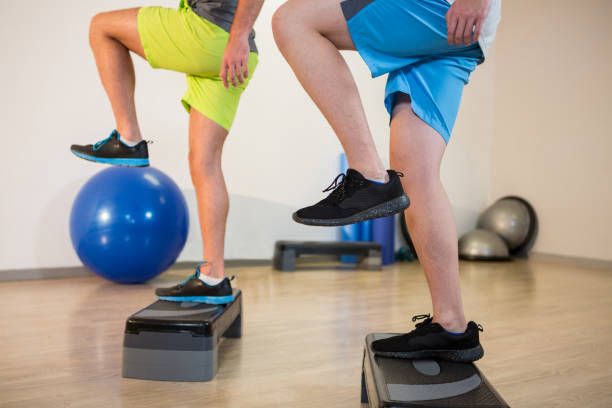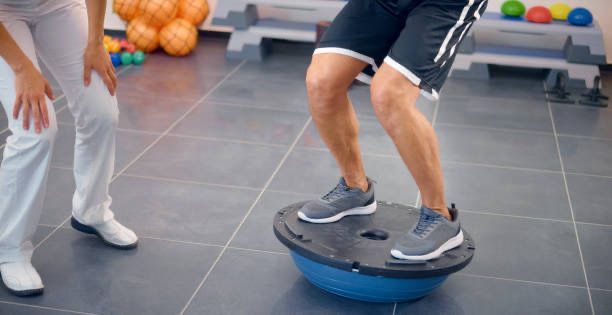Balance & Gait Training
Specialized training to improve stability, coordination, and walking patterns. Our comprehensive approach enhances balance confidence, reduces fall risk, and optimizes mobility for greater independence and quality of life.


What is Balance & Gait Training?
Balance and Gait Training is a specialized physiotherapy service focused on improving stability, coordination, and walking patterns. Balance—the ability to maintain your body's center of mass over its base of support—is essential for safe, efficient movement. Gait refers to your pattern of walking, including the rhythm, speed, step length, and the coordinated movements of your joints and muscles during walking.
This specialized training becomes important when balance or walking patterns are affected by injury, surgery, neurological conditions, aging, or other factors. Problems with balance or gait can significantly impact daily activities, independence, and quality of life, while also increasing the risk of falls and subsequent injuries. Our comprehensive approach addresses the underlying causes of balance and gait issues, not just the symptoms.
Through a detailed assessment, we identify specific areas that need improvement—whether it's muscle weakness, joint restrictions, sensory deficits, or coordination challenges. We then develop a personalized training program that progressively challenges your balance systems and retrains optimal movement patterns. Training involves a combination of targeted exercises, activities that simulate real-world challenges, and strategies to help you navigate various environments with greater confidence and safety. Our goal is to optimize your mobility, enhance your independence, and improve your overall quality of life.
Benefits of Balance & Gait Training
Discover how improving stability and walking patterns can enhance your daily life
Reduced risk of falls and injuries
Improved confidence in movement
Enhanced walking efficiency and stamina
Better coordination and stability
Increased independence in daily activities
Improved posture and alignment
Faster recovery from injuries or surgeries
Our Training Techniques
Specialized approaches we use for effective balance and gait improvement
Static and dynamic balance exercises
Gait pattern retraining
Vestibular rehabilitation techniques
Proprioceptive training
Strength and flexibility exercises
Obstacle course navigation
Dual-task training
Environmental adaptation strategies
Our Training Process
What to expect during your balance and gait rehabilitation journey with us
Comprehensive Assessment
Detailed evaluation of your balance, gait patterns, strength, and contributing factors.
Individualized Program
Development of a targeted training plan addressing your specific needs and goals.
Supervised Training
Expert guidance through progressive exercises in a safe, controlled environment.
Functional Integration
Application of improved balance and gait patterns to real-life activities and environments.
Conditions We Address
Our balance and gait training helps people with various conditions and concerns
Fall Risk and Fall Prevention
Stroke Recovery
Parkinson's Disease
Vestibular Disorders
Post-Surgical Rehabilitation
Lower Extremity Injuries
Neurological Conditions
Age-Related Balance Changes
Sports Performance Enhancement
Frequently Asked Questions
Find answers to common questions about our balance and gait training services
How do I know if I need balance and gait training?
You might benefit from balance and gait training if you've experienced any of the following: recent falls or near-falls, fear of falling that limits your activities, difficulty walking on uneven surfaces, changes in your walking pattern, feeling unsteady or off-balance, reliance on furniture or walls when moving around, dizziness when standing or walking, or recovery from an injury, surgery, or neurological condition that has affected your mobility. Additionally, if you're an older adult looking to maintain independence and prevent falls, or an athlete wanting to improve performance and reduce injury risk, proactive balance and gait training can be highly beneficial. During your initial assessment, we'll thoroughly evaluate your specific needs and determine if this specialized training is right for you.
How long does each balance and gait training session last?
Typical sessions last 45-60 minutes, though this may vary based on your condition, stamina, and specific goals. We carefully monitor your response to exercises and adjust the duration accordingly to avoid fatigue, which can increase fall risk. Initial sessions might be shorter as we establish your baseline capacity and tolerance. As your endurance improves, we may gradually increase session length. For some clients, particularly those with neurological conditions or significant deconditioning, we might recommend shorter but more frequent sessions. We'll work with you to develop an optimal schedule that maximizes benefits while respecting your energy levels and other commitments.
Will I need special equipment for home exercises?
Most home exercises we recommend initially require minimal or no special equipment. We focus first on exercises that use your body weight and everyday household items. As you progress, we might suggest simple, affordable tools like resistance bands, balance pads, or therapy balls to advance your training. For some clients, we recommend supportive devices such as a sturdy chair for standing exercises or temporary walking aids for specific training activities. We're mindful of space and budget constraints and will always work within your practical limitations. Our goal is to provide effective, accessible exercises that you can realistically incorporate into your daily routine for consistent practice and improvement.
How quickly will I see improvements in my balance and walking?
The timeline for improvement varies depending on several factors including your starting point, the underlying cause of your balance or gait issues, your age, overall health, and consistency with your exercise program. Many clients notice subjective improvements in confidence and stability within 2-4 weeks of regular training. Measurable improvements typically become evident within 4-8 weeks. Neurological conditions may require longer timeframes, while purely musculoskeletal issues often respond more quickly. We'll conduct regular reassessments using objective measures to track your progress. Even if improvements seem slow, remember that you're also working to prevent deterioration that might otherwise occur. Consistent practice is key—clients who diligently perform their home exercise program typically progress more rapidly.
Is balance training safe for someone with osteoporosis or other health conditions?
Yes, balance training can be safely adapted for individuals with osteoporosis and various other health conditions. In fact, appropriate balance training is especially important for those with osteoporosis to prevent falls and potential fractures. We modify all exercises based on your specific health concerns and safety needs. For osteoporosis, we avoid high-impact activities and movements that involve excessive spinal flexion or rotation. For cardiovascular conditions, we monitor exertion levels carefully. Neurological conditions may require specialized approaches with appropriate support and progression. Before beginning your program, we'll review your medical history thoroughly and may consult with your physician if needed. Our priority is always your safety, and we'll design a program that challenges your balance appropriately while respecting any medical considerations.